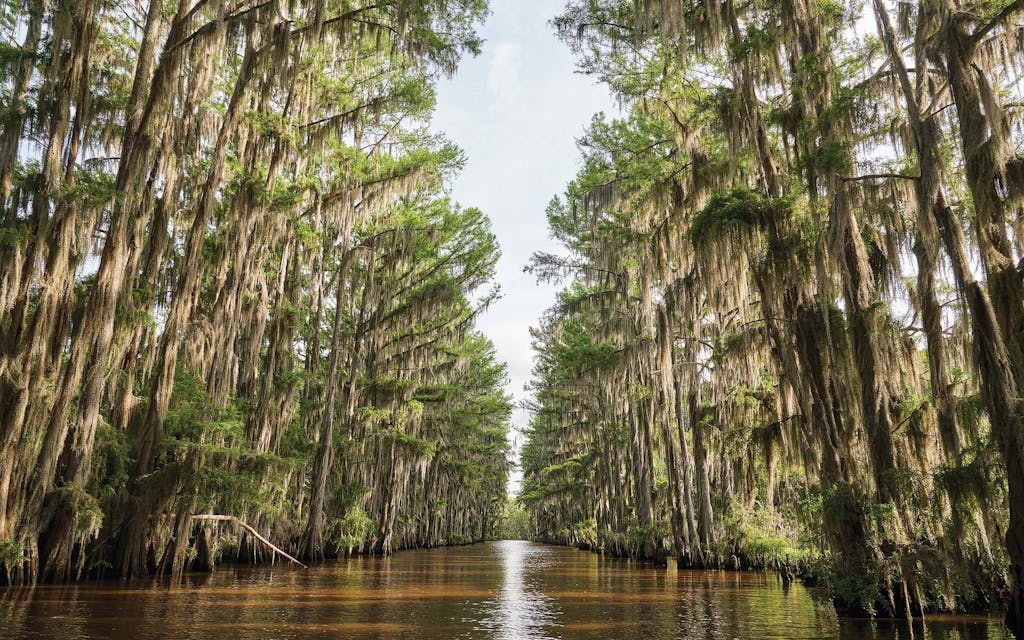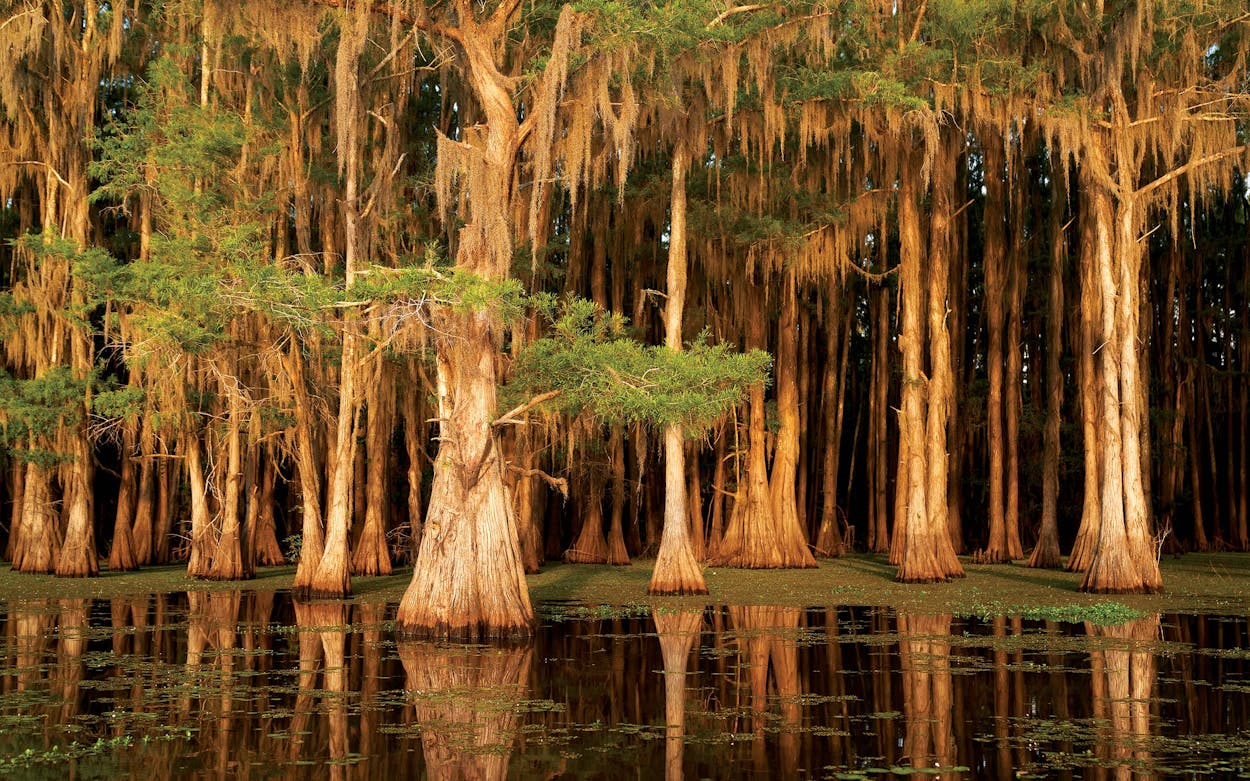About an hour before a torrential late-night downpour, Caddo Lake State Park came alive. Inside our roomy four-person tent, pitched forty yards or so from a large pond, my boyfriend, Sean, and I had settled into side-by-side cots, our shaggy little mutt, Bandit, curled up between us. We tried to sleep, but the world outside had other plans.
A chorus of tree frogs began singing in nasal honks all around us. Nearby ducks joined in with occasional quacks. Not quite as harmonious, some owls let out surprisingly humanlike screeches, and the shrill chirp of killdeer birds echoed all around. If any of these calls had been solo acts, I might have found them grating, even frightening, but the cacophony formed a strangely soothing kind of symphony. Then the rain came.
Camping in a thunderstorm is peak camping. A cool, starry night is great, but there’s nothing like listening to steady rainfall while you feel the rumble of thunder, a thrill heightened by knowing that only a thin layer of nylon-polyester blend and a tarp separate you from the elements. Maybe I should have been a little concerned that our site’s gravel tent pad didn’t offer much in the way of drainage, but that was a problem for the morning.
A storm was in the cards for us. That much was clear by the time we’d arrived at the park earlier that afternoon. We had driven about five hours northeast from Austin to Karnack. There weren’t any dark clouds, but the damp, earthy smell of imminent precipitation hit us the second we started setting up at one of the twenty sites in the Mill Pond Camping Area. It was late April, just a few days before the park’s historically wettest month of the year, and I wasn’t going to let the weather tamp down my excitement. Caddo Lake had been on my travel bucket list for years.
Everyone knows how big Texas is, but I’ve always thought the state seldom gets enough credit for just how varied its landscape is. To someone like me, who’s spent her entire life in San Antonio and the surrounding Hill Country, the iridescent waters and dense canopy of bald cypress trees in Caddo Lake seemed as enticing as the mountains in the Chihuahuan Desert or the canyons of the High Plains.
The park is nestled on the banks of the Big Cypress Bayou, part of Caddo Lake’s complicated, nearly 27,000-acre interconnected network of waterways—bayous, swamps, ponds, and sloughs—between Texas and Louisiana. The murky waters are surprisingly shallow, averaging between eight and ten feet in the lake and twenty feet in the bayou, though they nurture a thriving ecosystem that’s home to alligators, snapping turtles, beavers, ospreys, egrets, and herons. It’s one of the only places on Earth where you can find the paddlefish, the oldest surviving animal species on the continent.


Some claim that an even rarer creature lives around Caddo Lake as well: visitors have reported hundreds of bigfoot sightings. Although I didn’t see a Sasquatch lurking in the woods, I wouldn’t rule out its existence after spending time in this mysterious place.
Caddo Lake State Park’s campsites and screened shelters are all within walking distance of Mill Pond, which connects to the Big Cypress Bayou (it also offers cabins farther away). Visitors can fish for largemouth bass, crappie, and catfish or venture into the bayou via the canoes that are available for rent. And while the fifty miles of paddling trails might be more popular, the four hiking trails offer incredible views of the birds and the towering loblolly pines in which they perch.
Usually, I obsessively research and create an itinerary for my travels, but it somehow feels wrong to do that for a camping trip. I kept the plan simple: we would fish for a few hours, camp for the night, rent a canoe the next morning, and head to a bed-and-breakfast nearby before ending the trip with a bayou tour.
The following morning, though, we awoke to puddles of water in the tent and a small moat that we’d have to leap over to get to the car in the rain. We scrapped our canoeing plans, quickly packed our gear, and snaked through the winding roads out of the park toward Jefferson, a fifteen-minute drive away.
For a few decades in the mid-1800s, Jefferson was considered a crown jewel of the bayou, a booming port rivaled only by Galveston. The Red River had been plagued by the series of logjams for centuries. With each flood, the blockage known as the Great Raft continued to grow, eventually causing water to spill over and submerge the surrounding forest, which would become Caddo Lake. Starting in 1832, Captain Henry Miller Shreve oversaw attempts to clear the Raft and make boat travel possible on the Red River. His crew partially cleared it, making Caddo Lake and Big Cypress Bayou navigable—and eventually turning Jefferson into a veritable boomtown.
Steady traffic from steamboats carried cotton along with the latest fashions from New Orleans and a constant influx of settlers. But in the 1870s, the U.S. Army Corps of Engineers used nitroglycerin to clear the logjam once and for all, not realizing how drastically it would lower Caddo Lake’s water levels. Within a few years, most of the water drained away, and with it the city’s main source of commerce. Today Jefferson is known primarily for its historic homes, many of which have been converted to inns, giving the city its nickname, the Bed-and-Breakfast Capital of Texas.
Sean and I arrived at the Carriage House Bed and Breakfast just as the rain was letting up. The bright white Southern Colonial–style home with forest-green window frames set behind a white picket fence was almost too perfect. Built in 1920 in what is now the city’s historic downtown, the inn offers several lodging options, including two rooms in the main building as well as five private cottages on the property.
For the rest of the afternoon, we wandered the neighborhood, admiring the architecture, and settled in to watch a movie in our cottage after roasting a few marshmallows over the outside firepit. The next morning, we hustled out to the porch to enjoy our breakfast. Within a few minutes, we were digging into granola-stuffed baked apples, cheesy grits, eggs Benedict, and fruit. After telling our hosts goodbye, we got in the car and headed back toward the lake.

We’d apparently saved the best part of the trip for last. I’d booked a tour with Ole Jigger Caddo Lake Adventures, so we made our way to Karnack, where owner Mike Griffis was waiting at his private dock on Big Cypress Bayou. Soon on that cool Tuesday morning, the three of us and Bandit were squared away on a 25-foot pontoon boat.
Griffis keeps busy March through December, guiding visitors through the world’s largest forest of bald cypress trees as it transforms with each season. In the summer, this part of the bayou buzzes with watercraft as the summer crowd comes in to cool off. By then, Caddo is in full bloom, with white lily pads and yellow lotus flowers dotting the water. When fall arrives, the cypresses’ bright green needles turn to dazzling shades of crimson and burnt ocher. By winter, the trees have shed them completely, becoming skeleton forms that render the lake ghostly in the thick morning mist.
Over the next two hours or so, Griffis, a 65-year-old local, explained everything there was to know about the area. As he expertly navigated the labyrinthine waterways, we learned about the many lives of Caddo Lake, named for the Caddo Nation, which settled here about 2,200 years ago.
Traversing the water felt like traveling to the past, the shimmering reflection of hundreds of tree trunks looking just as frozen in time as the Petrified Forest. As the boat coasted past marinas and houses that lined the banks, Griffis took us back to the steamboat era, helping us to imagine the now-
quiet area as the “gateway to the West” before the cleared logjam rendered the lake a muddy bottomland. The low water levels were less than ideal
for some of the native plant life, but the cypress trees continued dropping their seeds in the mud.
In 1909 an oil rig cook named Sachihiko Ono Murata was wading through the muddy waters, collecting mussels for bait, when he found a pearl. Then another. After Murata sold them for at least $1,500 (to Tiffany & Co., in New York, if you believe the rumors), “people were coming from everywhere,” Griffis said, gesturing to the shoreline. “All along there, every day, people were out in the mud looking for pearls.” Until 1913, when a dam brought the water levels back up, the “pearl rush” attracted hundreds of hopeful harvesters.
Headed east toward the Louisiana border, we were also straddling the line between Harrison and Marion Counties. According to another local tale, with the end of Prohibition, in 1933, Marion residents voted to allow the sale of alcohol, while their neighbors to the south voted no. A floating bar and diner anchored to the Marion side provided the good citizens of Harrison a place to escape for drinks and dancing. A few other enterprising businessmen formed a buoyed entertainment strip that lasted until World War II.

Griffis guided the boat toward the shore, idling in front of a dilapidated shack on stilts. Known as Dick and Charlie’s Tea Room, it was once part of the strip and was rumored to have been a brothel. Nailed to a trunk a few feet above the water, a sign reads “House Rules: 1. There ain’t none. 2. There never was none. 3. There ain’t never gonna be none.”
We were turning back toward the cypress islands when Griffis pointed out a female osprey and her nest. Inside the carefully arranged bundle of sticks and grass was the fuzzy little head of a hatchling. Sean and I were taking in the sight of the pair when Griffis directed our attention to another tree a few feet away. “There’s the daddy,” he said, pointing out a sleek, if slightly smaller, brown-and-white raptor. “He’s probably been out getting food or more padding for the nest, and now he’s looking for a landing.” Sure enough, a few seconds later, the male took off, soaring above our heads before arriving home.
Our final detour was through Government Ditch—a drab name for one of the most stunning sections of the lake. At some point between the late nineteenth and early twentieth centuries, this passageway had been dredged to provide a shortcut for steamboats. Though the removal of the logjam rendered the path useless, today the corridor of two long, symmetrical rows of trees is one of the most photographed parts of the lake. For a few minutes, none of us spoke; we just looked up. We were completely closed in by walls of cypresses on either side, just taking in the dappled golden light that poked through the canopy above.
Caddo Lake feels so elusive that I know it would take more than a few visits to fully experience it. There’s no doubt that the waters hold many secrets. Beneath the surface, prehistoric paddlefish swim among undiscovered pearls. Even those who have called the area home for decades are still solving its mysteries. As Griffis told us just before he pulled back into the dock: “It changes every day.”
This article originally appeared in the July 2022 issue of Texas Monthly with the headline “The Many Lives of Caddo Lake.” Subscribe today.
- More About:
- Jefferson









